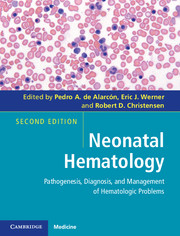Book contents
- Frontmatter
- Contents
- Contributors
- Foreword
- Preface
- 1 A historical review
- Section I Developmental hematology
- Section II Erythrocyte disorders
- 4 Anemia of prematurity and erythropoietin therapy
- 5 Bone marrow failure syndromes
- 6 Hemolytic disease of the fetus and newborn
- 7 Neonatal hemolysis
- 8 Neonatal screening for red blood cell disorders
- 9 Polycythemia and hyperviscosity in the newborn
- Section III Platelet disorders
- Section IV Leukocyte disorders
- Section V Immunologic disorders
- Section VI Hemostatic disorders
- Section VII Transfusional medicine
- Section VIII Miscellaneous
- Index
- Plate section
- References
8 - Neonatal screening for red blood cell disorders
from Section II - Erythrocyte disorders
Published online by Cambridge University Press: 05 February 2013
- Frontmatter
- Contents
- Contributors
- Foreword
- Preface
- 1 A historical review
- Section I Developmental hematology
- Section II Erythrocyte disorders
- 4 Anemia of prematurity and erythropoietin therapy
- 5 Bone marrow failure syndromes
- 6 Hemolytic disease of the fetus and newborn
- 7 Neonatal hemolysis
- 8 Neonatal screening for red blood cell disorders
- 9 Polycythemia and hyperviscosity in the newborn
- Section III Platelet disorders
- Section IV Leukocyte disorders
- Section V Immunologic disorders
- Section VI Hemostatic disorders
- Section VII Transfusional medicine
- Section VIII Miscellaneous
- Index
- Plate section
- References
Summary
Introduction
The history of neonatal screening for sickle cell disease (SCD) and other hemoglobinopathies began in 1974 with the demonstration that hemoglobin electrophoresis could be applied successfully to samples of umbilical-cord blood or capillary blood collected on filter paper (1–3). This approach provided adequate differentiation of important adult hemoglobin (Hb) variants, such as sickle hemoglobin (Hb S) and Hb C, from normal adult hemoglobin (Hb A) in the presence of large amounts of fetal hemoglobin (Hb F). State-wide programs initiated in New York in 1975 and Colorado in 1979 demonstrated the feasibility of universal screening by public health laboratories that utilized filter paper samples already being collected for phenylketonuria screening (4–5). In 1986, the demonstration that prophylactic penicillin markedly reduces the incidence of pneumococcal sepsis, the leading cause of death in children with SCD, provided a strong incentive for neonatal screening (6). One year later, a consensus development conference of the National Institutes of Health reviewed evidence that neonatal screening, when linked to timely diagnostic testing, education, and comprehensive medical care, markedly reduces morbidity and mortality from SCD in infancy and early childhood (6–8). The panel recommended that all neonates in the USA be screened for SCD (9). The full implementation of this recommendation for universal screening was not achieved until 2006 (10). Currently, all 50 states in the USA, the District of Columbia, Puerto Rico, and the Virgin Islands conduct universal hemoglobinopathy screening. A number of other countries have implemented either universal or targeted neonatal screening for hemoglobinopathies (11).
Approximately 2000 infants with SCD are identified annually by US neonatal screening programs (12–13). Data from a number of programs indicate that mortality from SCD during the first 3 to 4 years of life has been reduced markedly by universal screening and appropriate follow-up and treatment (5, 14–20). Screening can also identify infants with other hemoglobinopathies, including some with severe forms of β-thalassemia and most with α-thalassemia, as well as hemoglobinopathy carriers (i.e., those with hemoglobin traits). The benefit of presymptomatic diagnosis for these other disorders is less clear than for SCD, but significant complications may occur in infancy and childhood for these disorders (21). Many of these results may also have important genetic implications for families (22).
- Type
- Chapter
- Information
- Neonatal HematologyPathogenesis, Diagnosis, and Management of Hematologic Problems, pp. 118 - 126Publisher: Cambridge University PressPrint publication year: 2013



